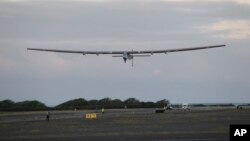A solar plane on an around-the-world journey has reached the point of no return over the Pacific Ocean after departing Hawaii, and now it's California or bust.
The plane was cruising over the cold northern Pacific early Friday — Earth Day — an occasion the team planned to mark with a live call between pilot Bertrand Piccard and Secretary-General Ban Ki-moon, according to the website that's documenting the journey of Solar Impulse 2.
After some uncertainty about winds, the plane took off from Hawaii Thursday morning and was on course to land in Mountain View, California, over the weekend. The crew that helped it take off was clearing out of its Hawaiian hangar and headed for the mainland for the weekend arrival.
"We have passed the point of no return," the team wrote on the website. "From this point onwards, Bertrand Piccard will only be moving forward with Si2."
At one point passengers on a Hawaiian Air jet caught a glimpse of the Solar Impulse 2 before the powerful airliner sped past the slow-moving aircraft.
The Solar Impulse 2 landed in Hawaii in July and was forced to stay in the islands after the plane's battery system sustained heat damage on its trip from Japan.
The aircraft started its around-the-world journey in March 2015 from Abu Dhabi, the capital of the United Arab Emirates, and made stops in Oman, Myanmar, China and Japan. It's on the ninth leg of its circumnavigation.
Piccard, said the idea of crossing the ocean in a solar-powered plane a few years ago stressed him out, but Thursday he was confident things would go according to plan.
Piccard also said the destination in the heart of Silicon Valley is fitting, as the plane will land "in the middle of the pioneering spirit."
Piccard's co-pilot Andre Borschberg, who flew the leg from Japan to Hawaii, told Piccard he greatly admires his dedication and strength.
He said the plane "represents what we could do on the ground in our communities."
The team was delayed in Asia, as well. When first attempting to fly from Nanjing, China, to Hawaii, the crew had to divert to Japan because of unfavorable weather and a damaged wing.
A month later, when weather conditions were right, the plane departed from Nagoya in central Japan for Hawaii.
The trans-Pacific leg is the riskiest part of the plane's global travels due to the lack of emergency landing sites.
The plane's ideal flight speed is about 28 mph, though that can double during the day when the sun's rays are strongest. The carbon-fiber aircraft weighs more than 5,000 pounds, or about as much as a midsize truck.
The wings of Solar Impulse 2, which stretch wider than those of a Boeing 747, are equipped with 17,000 solar cells that power propellers and charge batteries. The plane runs on stored energy at night.





